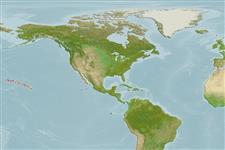Environment: milieu / climate zone / depth range / distribution range
Ökologie
seewasser bathydemersal; tiefenbereich 220 - 475 m (Ref. 84366). Temperate
Eastern Central Pacific: Hawaiian Islands.
Size / Gewicht / Alter
Maturity: Lm ? range ? - ? cm
Max length : 47.3 cm TL Männchen/unbestimmt; (Ref. 84366)
Kurzbeschreibung
Morphologie | Morphometrie
Wirbelzahl: 180 - 185. This moderately elongate species of Ophichthus, subgenus Coecilophis is distinguished by the following characters: tail 59-60%, head 9.6-10.1% of total length and body depth at gill opening 3.2-3.7% of TL; origin of dorsal-fin above mid pectoral fin; elongate pectoral fin, non-filamentous; posterior margin or orbit in advance of rictus; posterior nostril a hole above upper lip is covered by a flap; no lip barbels; small but conspicuous head pores, SO 1+4, IO 4+2, POM 2+5; small, conical teeth, biserial on anterior vomer and jaws; uniform gray brown in color, lighter ventrally, fins pale except anal which has a dark patch at posterior base; mean vertebral formula 15/66/182, total vertebrae 180-185 (Ref. 84366).
Benthic on fine sand or hard substrata with crevices (Ref. 58302).
Life cycle and mating behavior
Geschlechtsreife | Fortpflanzung | Ablaichen | Eier | Fecundity | Larven
Eschmeyer, W.N. (ed.), 1998. Catalog of fishes. Special Publication, California Academy of Sciences, San Francisco. 3 vols. 2905 p. (Ref. 26282)
IUCN Rote Liste Status (Ref. 130435)
Bedrohung für Menschen
Harmless
Nutzung durch Menschen
Mehr Information
NamenSynonymeMetabolismusRäuberÖkotoxikologieFortpflanzungGeschlechtsreifeAblaichenSpawning aggregationFecundityEierEientwicklung
Alter/GrößeWachstumLänge-GewichtLänge-LängeLängenhäufigkeitenMorphometrieMorphologieLarvenLarven Pop.Dyn.RekrutierungDichteBRUVS
ReferenzenAquakulturAquakultur ProfilZuchtlinienGenetikElectrophoresesVererbbarkeitKrankheitenVerarbeitungNutrientsMass conversion
PartnerBilderStamps, Coins Misc.LauteCiguateraGeschwindigkeitSchwimmstilKiemenoberflächeOtolithsGehirngrößeSehfähigkeit
Tools
Zusatzinformationen
Download XML
Internet Quellen
Estimates based on models
Preferred temperature (Ref.
123201): 13.1 - 13.8, mean 13.6 °C (based on 12 cells).
Phylogenetic diversity index (Ref.
82804): PD
50 = 0.5000 [Uniqueness, from 0.5 = low to 2.0 = high].
Bayesian length-weight: a=0.00089 (0.00039 - 0.00204), b=3.00 (2.80 - 3.20), in cm total length, based on LWR estimates for this (Sub)family-body shape (Ref.
93245).
Trophic level (Ref.
69278): 3.9 ±0.7 se; based on size and trophs of closest relatives
Widerstandsfähigkeit (Ref.
120179): hoch, Verdopplung der Population dauert weniger als 15 Monate. (Preliminary K or Fecundity.).
Fishing Vulnerability (Ref.
59153): Moderate vulnerability (37 of 100).
